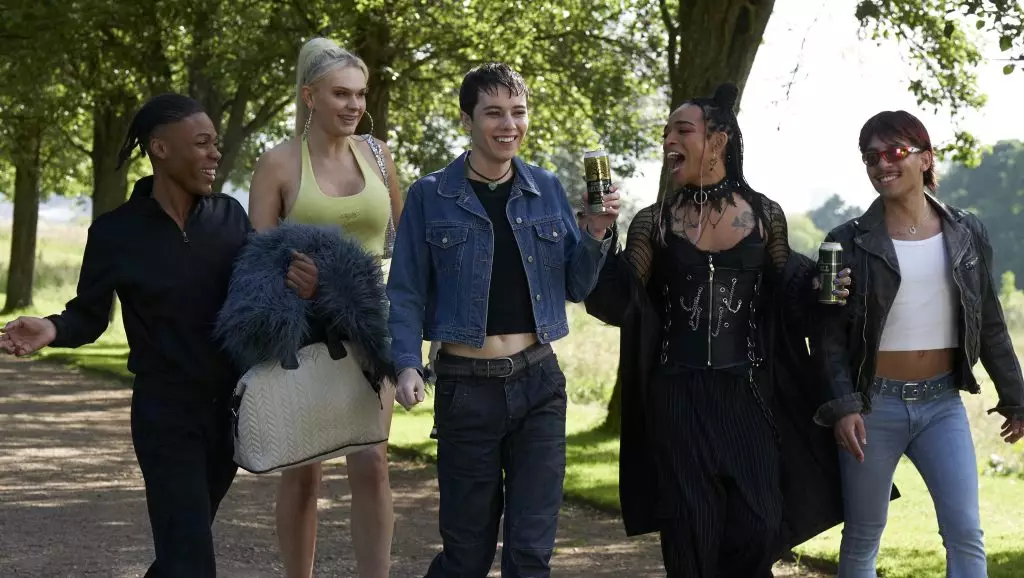The BBC’s latest venture into storytelling, “What It Feels Like For A Girl,” serves as a bold adaptation of Paris Lees’ poignant memoir. The decision to adapt such a deeply personal account into an eight-part series is commendable, especially as it shines a powerful light on the often underrepresented transgender experience in mainstream media. This series is destined to be more than a simple retelling; it’s an opportunity to navigate the complexities of identity, societal expectations, and self-discovery in a world still wrestling with the nuances of gender.
At its heart, the series explores the life of Byron, portrayed by Ellis Howard, a character that embodies the struggles faced by many queer youth. Moving from the stifling confines of a small town to the vibrant, chaotic world of Nottingham’s club scene, Byron’s journey is both a physical and emotional escape. This duality of flight signifies more than mere rebellion; it illustrates the profound need for acceptance and belonging that resonates universally.
The Complexity of Casting
Casting Ellis Howard in the lead role is a stroke of genius. Lees’ insight into identifying a “cheekiness” and “delicateness” in Howard speaks volumes about the character’s requirements. The role demands not only talent but also an authentic representation of the transgender experience, which is often overlooked. Choosing an actor capable of capturing the subtle nuances of Byron’s transformation from a schoolboy to a budding trans woman entering university highlights the show’s commitment to authenticity over simply filling a role.
Supporting this cast are notable actors like Laura Haddock and Michael Socha, each adding depth to the chaotic backdrop of institutional barriers, familial challenges, and self-acceptance. The ensemble raises the stakes of Byron’s narrative, showcasing the breadth of characters that populate his life, from rivalries to friendships, all of which serve as catalysts in his quest for identity.
An Exploration of Friendship and Rivalry
The narrative promises a thrilling tapestry woven with threads of euphoria and turmoil. At the center, Byron’s interactions with a colorful cast, including the endearing yet chaotic Troublemakers — The Fallen Divas — introduce themes of camaraderie that permeate the nightlife of the early 2000s. Here lies the brilliance: while one might assume that hedonism is liberating, it also leads to a reckoning. More than just a party, this world is where Byron forms critical relationships, navigating the complexities of friendship, rivalry, and the pursuit of freedom.
The mention of an “intense rivalry” with a character like Sasha showcases a classic narrative conflict, yet it emerges in a setting that’s unfamiliar to mainstream storytelling. This rivalry reflects the myriad challenges within the LGBTQ+ community, where competition and jealousy can sometimes overshadow solidarity. The dynamic promises to evoke both empathy and conflict as audiences navigate Byron’s emotional landscape.
The Heart of the Story: Transformation and Consequence
As noted in the logline, Byron’s seductive encounter with bad-boy Liam acts as a pivotal plot point, resulting in an unexpected event that challenges everything Byron has learned. Such twists are not just narrative devices; they are reflective of the harsh realities faced by many youths who dare to step outside societal norms. This approach invites viewers to question and confront their own biases, providing a necessary lens through which to view the tumultuous nature of growing up queer.
The creative team behind the adaptation, comprising notable names such as Brian Welsh and Paris Lees, reinforces the belief that authentic narratives can emerge only when those who have lived them participate in their storytelling. This collaboration not only preserves the integrity of Lees’ memoir but also invites a fresh, modern take on the struggles of coming-of-age in a society resistant to change.
Significance in Contemporary Media
“What It Feels Like For A Girl” marks a significant departure from traditional narratives, positioning itself as a beacon for representation in contemporary media. Its release on platforms like BBC3 and iPlayer ensures that this important story is accessible, providing a broader audience the opportunity to engage with these crucial themes of self-identity and acceptance. However, the success of this series ultimately hinges not only on its casting and plot but also on its ability to spark honest conversations about gender, society, and our collective responsibility in nurturing understanding in an ever-evolving world. As viewers, we should hold that key responsibility in our hands, ready to unlock the treasure of authentic human stories.
